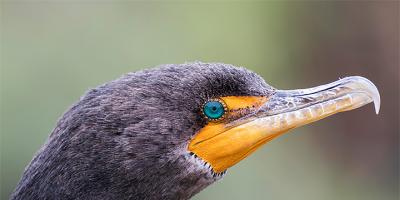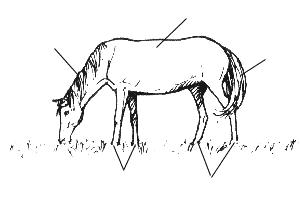Bamboo is very ancient plant tropical and subtropical zones of Southeast Asia and Brazil, a plant symbol of the countries of this geographical region, where it is considered a “harbinger of joy”, capable of attracting good luck, prosperity and happiness to its owners. Currently widely used as a crop for decoration " Japanese garden"and in indoor culture to create exotic compositions from its rooted branches in various vases on hydroponics, hydrogel or on a soil base in pots. Green foliage, intricate tortuosity of branches and ease of care attract many lovers of home greens.
In places of natural growth, bamboo (Bambusa lat.) belongs to the genus of evergreen perennials, the family Cereals, represented by 130 of its varieties. In nature, these are lignified stems (straws), reaching a height of 35 meters, densely branched in the upper part. They are distinguished by their rapid growth of up to 0.75 centimeters per day (the growth champion among terrestrial plants). Leaves with very short petioles, lanceolate. They bloom only in endemic conditions.
In home culture, bamboo is a bare stem of different colors from bright green to yellow color, decorated with upper leaves. Its hue is determined by the lighting in the places where it is kept. Thanks to the plasticity of its stems, which easily bend and twist in a spiral, this plant makes it possible to form a bonsai.
Bamboo differs for indoor growing just the diameter of the stem and its height, even its color is related only to the intensity of lighting.
Medium height bamboo
The maximum height of such plants in Japan, where they originated, is no higher than 4 meters. They are photophilous and resistant to direct sunlight. Among them there are specimens with white-green leaves.
Low growing bamboo
This is the most compact plant variety, most suitable for green decoration of both home and office interiors. Its height reaches no more than 1.5 meters. In addition, low-growing bamboo, originally from Brazil, prefers relative coolness and moisture-rich air.
Features of growing indoor bamboo
- Considering the increased requirements of this plant for air humidity, pots or vases with it should not be placed near sources of any type of heating, especially electric.
- 25 warm degrees, with a small temperature amplitude, are considered comfortable for growing bamboo at home.
- Like many other indoor plants, bamboo needs mineral feeding. To keep the plant healthy and the foliage juicy and lush, it is necessary to add fertilizers containing phosphorus and nitrogen to the soil of the container where it grows in proportionate proportions.
- When rooting bamboo or replanting it in fresh soil, the plant can be fertilized only after its complete adaptation and obvious growth dynamics.

Bamboo is grown at home in different ways:
- in water;
- in a container with soil for dracaenas;
- in hydrogel.
The choice of growing method remains up to the grower, but you should immediately warn that varnishes and hydrogels are quite expensive for the reason that they need frequent replacement due to the loss of their original properties. If you keep bamboo stems in them longer than their intended shelf life, the plant will begin to wither.
Growing bamboo in a container with soil:
Most of all, despite all the unpretentiousness to soil quality, a soil mixture for dracaenas is suitable for bamboo. The planting container should be spacious, taking into account the rapid growth of its root system. Young specimens of indoor bamboo need to be replanted into a larger pot annually, and mature specimens - once every 3 years. Especially new plantings should be kept moist for 2 weeks. In further caring for them, do not allow the soil to dry out.

Growing bamboo in water:
There is an opinion that growing this tropical plant in water, in its natural habitat, gives the best result: lush greenery, a strong stem, but this method also requires knowledge and discipline in care:
- They start with the root system: remove weak and overgrown ones - bamboo will calmly survive the removal of even one third of its roots.
- They choose a suitable container and get decorative-looking stones - they wash both thoroughly, and the stones are boiled in water.
- Water for such planting should be distilled or filtered, but possibly settled.
- Place the bamboo stems into the prepared container and, straightening the roots evenly, carefully lay them with stones, creating support for them. Lastly, pour a sufficient amount of prepared water into the container with the planted plant.
- Once every two weeks or more often (if there is a smell of mustiness, cloudiness, foam or bubbles), the water is completely changed, and in advanced cases, the stones are also washed.
- When growing in this way, the water in a container with bamboo is fertilized once a month with a specialized fertilizer containing nitrogen and phosphorus.
Growing bamboo on hydrogel
The process of planting into hydrogel granules is the same as when using decorative stones. The prepared stems are covered with granules, held in an upright position, and filled with prepared water. All further care consists of periodically adding water and applying appropriate fertilizer once every six months. Transparent glass containers with growing bamboo in hydrogel are very decorative.
Over time, the granules in a transparent container gradually change color, and the bamboo roots may become exposed, crawling up and drying out, which should not be allowed.

In addition to low-growing species, bamboo is a heat-loving plant, sensitive to cool drafts, and in winter time You should ventilate the room with bamboo very carefully. Lighting through eastern windows is more comfortable for him. The intensity of illumination is related to the size of its instance: than bigger plant, the closer to the light source. Diffuse light and even partial shade are allowed. In summer it needs frequent watering, and in winter it requires dosed and moderate watering.
Secrets of caring for indoor bamboo:
- It is important to maintain a balance of light and shadow: with a lack of lighting, the stems stretch out and lose their decorative effect, but with an excess of it, the foliage grows excessively and there is a need for frequent pruning.
- Under natural conditions, bamboo blooms only at the age of 30 and dies immediately. It is for this reason that you cannot overdo it with fertilizers, as this can lead to flowering of the stems and their natural death. The flowers are white and very fragrant - one stem, planted separately, can be sacrificed to admire the flowering of bamboo.
- Growing indoor bamboo involves periodically pruning it according to following rules: shoots can only be cut 5 centimeters above the node; By cutting off the top, the plant will stop growing in height and it will begin to grow leaves, constantly changing its shape.
- Make sure to replant the plant in a timely manner, otherwise it will lose its leaves.
- During the warm season, a container with bamboo can be taken out onto the balcony or into the garden - it benefits from fresh air in the wind.
- Regular spraying of the plant will help maintain sufficient air humidity in the room.

- Strong stems and mature shoots are suitable for propagation by cuttings. It is necessary to cut the cuttings with several nodes and immediately root them in water or suitable soil with constant moisture and optimal lighting.
- When replanting, dividing a bush is effective, in which a developed shoot with a sufficient root system is separated and the young plant is rooted using the method chosen from the above.

Diseases and pests of indoor bamboo
- appear on the leaves dark spots- sign fungal disease. Treatment with a fungicide and ventilation of the room is necessary.
- Bamboo does not develop well - there is a deficiency of nutrients in the soil or water. Fertilizing should be strictly dosed, starting with minimal doses.
- Violation temperature regime leads to darkening, softness and shedding of leaves. There is a need to create temperature norm within 25 warm degrees with sufficient humidity.
- Periodically, bamboo leaves should be carefully inspected to identify pests: spider mite or aphids. If any are found, remove damaged leaves and wash the plant. soap solution and treat with the appropriate insecticide according to the instructions supplied with it.
As in most cases with domestic flora, diseases and pests of unpretentious and tenacious bamboo are associated with violation of the rules of care and conditions for its correct maintenance.
What you didn't know about indoor bamboo
In the area of names of bamboo varieties in Lately changes have occurred, which leads to a certain confusion among those gardeners who know their previous names. A comparative list of these changes would be useful.
| New name: | Old name: |
| Bashania fargesii | Arundinaria fargesii |
| Pseudosasa japonica | A. japonica |
| Fargesia murienaliae | A. murienaliae |
| F. nitida | A.nitida |
| F. palmata | A. palmata |
| Pleoblastus pygmaeus | A. pygmaea |
| P. variegatus | A. variegata |
| P. auricomus | A. viridistriata |
| Indocalamus tessellatus | Sasa tessellata |
Bamboo growing in containers can be replanted in any season. open ground, not coinciding with frosts and droughts, in places protected from direct cold winds, it is imperative to mulch the root zone to preserve moisture.
A clump of bamboo planted in a spacious and large pot looks picturesque on a balcony or in a patio with normal, regular watering, for which the short and cold-resistant species Shibatea kumasasa is most suitable.
If you want to grow taller bamboo (Fargesia murienaliae or F. nitida) in a pot, you will need not only a large pot, but also one that is heavy enough so that it will not be knocked over by the wind, but this is due to the need to replant the bamboos into a larger pot each year, since they are quite grow quickly.
Bamboo growing in a pot on the balcony can be left there in winter, covering its soil layer with a thick layer of straw and wrapping the entire curtain with the pot in several layers of polyethylene, loosely tying it with a rope to the very top.
Indoor or decorative bamboo belongs to the family Dracaenaceae(Dracaena Sandera). Discovered it amazing plant world in the 19th century, the English florist Frederick Sander during his trip to China.
In its homeland, decorative bamboo is considered a symbol of prosperity.
There are several subspecies of decorative bamboo on sale - they differ in shades(from gray to golden) and height. Some species of Dracaena Sander grow up to 40 cm in height; there are species reaching a height of 2.5 m.
Choosing a place to grow indoor bamboo
Caring for a bamboo houseplant is very simple - this plant is surprisingly unpretentious. Bamboo does not like direct sunlight; diffused sunlight is ideal for it. sunlight. You can place a pot with a plant on the eastern windowsill, but provide it with reliable shading.
You can place bamboo and on the floor, closer to the window. When choosing a place for your plant, remember that partial shade is more comfortable for it than prolonged exposure to sunlight.
Range temperature The temperature at which Dracaena Sander feels comfortable is quite wide - from +17 to +30 °C. But it should be protected from drafts. In winter, you should move the plant away from a window that opens for ventilation.
Bamboo in water
 What is the best way to care for indoor bamboo if it develops in water? It's simple. Because this is the best environment for him. Ordinary tap water won't do. You can use rain or melt water.
What is the best way to care for indoor bamboo if it develops in water? It's simple. Because this is the best environment for him. Ordinary tap water won't do. You can use rain or melt water.
In urban conditions, it is very simple to “organize” melt water - dial plastic bottle tap water, put it in the freezer and wait until it freezes completely.
When defrosting water, leave an unmelted piece of ice about the size of egg– this is where all the harmful biocidal additives and chlorine remain.
Once a week The water in the container needs to be changed. This is important - stagnant, stale water will cause mold to appear on the roots. If your bamboo grows in a transparent vase, you can add colorful stones or decorative pebbles for beauty. But be sure to rinse them with boiling water to destroy possible germs. This procedure should be repeated regularly.
Eliminate bacteria and bad smell will help charcoal. It is antibacterial and your plant will love it. From time to time, just add a little of it to the container with bamboo.
The soil
In the ground decorative bamboo also does well. No need to buy soil for ornamental plants, an abundance of peat will harm this dracaena.
Will do ordinary land for flowerpots and even from the garden bed, mixed in a 4:1 ratio with expanded clay, you can add a little sand. It is also important to choose a pot with drainage holes at the bottom and a drainage layer. Their absence will lead to mold on the roots and plant diseases.
Watering
Decorative bamboo needs humid environment. Watering should be abundant and frequent, especially in summer. In winter, plant development stops and watering can be reduced slightly. But the earthen lump should always be moist. For watering Melt or rain water is also needed.
IN spraying bamboo doesn't need it. It is important for him to regularly wipe the trunk, leaves with a damp cloth and remove dust.
Top dressing
Dracaena Sandera loves soil rich in minerals and organic matter. Sufficient saturation with nitrogen and phosphorus is also important. Choose special mineral fertilizers for dracaenas with a large composition of these substances in the store.
Autumn and winter feeding bamboo needs to be done once every three months. In spring and summer, carry out the procedure once every three weeks. If feeding is not enough, then the question may arise - why is your indoor bamboo starts to turn yellow and what to do?
This sign will indicate the need additional food to prevent growth slowdown. If your plant drops its leaves, do not remove them from the pot - the bamboo will not like it.
Transfer
Before the bamboo is 3 years old, it must be transplant every spring. Then this procedure can be carried out every two years. But, with intensive growth, this will have to be done more often. For bamboo, the distance from the roots to the walls of the pot (at least 5 cm) is extremely important. Replanting plant, keep in mind that the roots develop horizontally and choose a pot “for growth”.
After transplant bamboo should be watered more intensively to feed the weakened root system.
Reproduction
 Dracaena sandera seeds does not reproduce. Typically easiest to propagate indoor plant bamboo as a result of pruning. Both stems and strong shoots are suitable for this purpose.
Dracaena sandera seeds does not reproduce. Typically easiest to propagate indoor plant bamboo as a result of pruning. Both stems and strong shoots are suitable for this purpose.
Bamboo is good because its stems can be formed into intricate spirals. To do this, you will have to cut off the shoots; they are used to propagate the plant.
Escapes After cutting, indoor bamboo can be immersed in water until new roots appear. You can plant them immediately in the ground, but provide more intense lighting and abundant watering.
Reproduction is less commonly used dividing the root system. This procedure is undertaken while indoor bamboo is being planted. In this case, you can also put the new plant in water or plant it in the soil.
Diseases of indoor bamboo
Kit diseases of this plant is kept to a minimum. The most common problem is yellowing of leaves and stems. The cause of the disease There may be damage by fungus or bacteria, insufficient nutrition, poor-quality water for irrigation, insufficient drainage, or untimely replacement of water in the container.
If the reason is not proper care, correct errors. Yellowed leaves and even the stems need to be trimmed. This must be done quickly, even after small spots appear. Leave the cut for several hours, it should dry out. Then disinfect it with powdered charcoal. After 2-3 hours, remove the charcoal from the cut and cover it with soft wax.
If your bamboo started to dry out, perhaps too bright lighting bothers him.
Pests Dracaena Sander is affected very rarely. The main pests of decorative bamboo, as well as many indoor plants, are and. It can be saved by washing the leaves and stems with soapy water.
For the most curious, we offer a short video description of Dracaena Sander.
Almost every home has potted plants. They not only purify the indoor air, but are also a great addition to any interior. Recently it has become fashionable grow bamboo at home. He is not whimsical and does not require special care. Flower sellers claim that it grows well in an ordinary vase with water and does not require planting in the ground. But, if you pay attention to the natural growing environment of bamboo, it becomes clear that the plant grows in the ground, and not in water. Therefore, in order for the plant to feel most comfortable and please you longer with its wonderful appearance, it should be planted in the ground.
How to plant bamboo in the ground correctly?
- To begin, select a suitable pot and make an earthen mixture. It is made from turf and leaf soil, humus and sand are added. The ratio should be 2:1:1:1.
- Drainage is poured onto the bottom of the pot, then soil. Bamboo is planted in a deep hole. In this case, the ground should be well watered.
- The planted plant is placed on the sunny side. But try to avoid direct sunlight on the stems, otherwise the bamboo may burn.
- After a week, the plant can be fed with complex fertilizer.
Transplantation must be carried out annually, best time for this March-April. At this time the plant enters the period active growth and he just needs more space. In summer and winter, bamboo needs to be watered frequently, and in winter it is necessary to reduce the amount of watering. To protect the plant from pests, spray it with plain water twice a day and treat it once a month by special means. In addition to the fact that bamboo is grown at home, it can be planted in the garden in the summer. There it will feel great and produce abundant growth.
The houseplant bamboo is an evergreen, perennial, with a green, fleshy trunk, on which lance-shaped leaves are located on top. In nature, it can reach a height of up to several meters; at home, its height is usually limited, not allowing it to grow above 1 m - a plant that is too tall loses its decorative appeal, unless we are talking about some very elegant trunk shape.
In fact, the indoor plant, which we usually call “indoor bamboo,” only looks like real wild bamboo in appearance. But in fact it is called Dracaena sandera and is one of the types of shrubs dracaena. In cultivation it blooms extremely rarely, with small white flowers that have a sweetish aroma. Indoor bamboo is valued for decorative look, attracting with its green foliage and the ability to form an unusually shaped trunk. And also, according to Feng Shui, it brings good luck and attracts money to the house.
Indoor bamboo: care and propagation
As a houseplant, bamboo is not very demanding; caring for it is relatively easy. It is very important for him to choose the right lighting - he loves bright, but diffused light, while his leaves do not tolerate direct rays of the sun - they turn yellow and can wither. The best place for him - eastern or south-eastern windows. If the leaves begin to turn yellow, then one of the reasons may be excessive amounts of light; in this case, the plant can even be moved to partial shade
Temperature
Despite its tropical origin, indoor bamboo does not tolerate too much high temperature, if it exceeds 35°C, he will die. Optimal temperature, at which care will give best results– within 22-24°C, in winter the room temperature can drop to 14-16°C, but not lower than 12°C.
Humidity
The plant is not demanding on humidity levels, but if the air is too dry, it is recommended to spray it. Once a month, it is advisable to wipe the leaves with a damp cloth.
Landing
To grow bamboo, you can use ready-made universal primer(or special for dracaenas), or prepare a soil mixture yourself by mixing humus, peat, sand, turf soil and leaves in equal parts. An important requirement is good drainage, so the pot should not only have a hole, but also additional drainage at the bottom made of expanded clay or pebbles. Despite the fact that bamboo loves moisture very much, its stagnation will lead to damage to the root system.
Indoor bamboo grown in water looks very decorative and impressive. For this purpose they select a beautiful transparent vase, beautiful pebbles are poured inside and a bamboo cutting is installed. Water must be distilled, alternatively rain or melt water, room temperature. The main care for such “planting” is to completely change the water every two weeks, and it is necessary to add mineral fertilizers used to feed dracaenas. Otherwise, due to lack of nutrients, the bamboo leaves turn yellow and may fall off.
If the water begins to smell unpleasant or loses its transparency or becomes cloudy, then it must be replaced without waiting for 2 weeks. Another sign that the water is not suitable and needs to be replaced is that the plant’s leaves begin to turn yellow. Bamboo grown in aquagel looks very expressive in the photo, while the rules of care remain the same as when grown in water.
Advice! It is necessary to maintain a low water level in the vase, otherwise small but very unattractive roots will begin to appear along the entire length of the trunk located in the water.
Watering
In summer, bamboo needs frequent and abundant watering, as soon as the soil in the pot has dried out. In the off-season and winter, water the plant moderately, keeping the soil slightly moist.
Transfer
Up to three years, the young plant is replanted annually, choosing a larger pot, because bamboo grows quite quickly. An adult bamboo needs to be replanted every 3 years.
Top dressing
In summer the flower is fertilized mineral fertilizers for dracaenas once every 3 weeks, in winter - once every 2 months. It is permissible to add liquid organic fertilizers based on peat.
Trimming
Strongly grown bamboo does not look very attractive, so it is advisable to prune it annually.
Advice! To make the cut look beautiful, it is carried out with special scissors immediately above the knot.
When pruning, long shoots are trimmed on all sides, and if necessary, external reeds are removed at ground level. Removing from the right sides side shoots, you can simulate the look and shape of bamboo, giving it the shape of your own desire. The cuttings obtained during pruning can later be used for propagation. If after pruning a new shoot does not sprout, then the top is cut - after this a new shoot should break through.
Advice! Be sure to trim off yellowed stems and leaves. After allowing the cut area to dry a little, it must be sprinkled with charcoal powder or lubricated with soft wax.
Reproduction
The optimal way to propagate indoor bamboo is vegetatively; for this, cuttings remaining after pruning are used, discarding the yellowed areas of the trunk. Propagation by cuttings can be carried out at any time of the year. And although in flower shops Sometimes you can find seeds of domestic bamboo; its propagation in this way at home is almost impossible.
The cutting must be placed in water until roots appear. After this, it is rooted by choosing a spacious pot and filling it with ready-made soil mixture for dracaenas. The main requirements for propagation to go well and for the young plant to take root well and begin to grow are sufficient watering, plenty of light and fertilization once every 2 weeks.
How to twist a bamboo trunk
Many buyers of indoor bamboo are attracted by the opportunity to get a trunk unusual shape, the most common type is twisted (spiral). This will require special care, this process is not quick, so patience is required:
- when planting a young cutting, it is placed vertically, but for the time when the buds are forming, it must be completely covered with something, leaving only a small hole (window) through which light will penetrate. The sprouts will tend towards it, and in order to “curl” them, it will be necessary to periodically rotate either the flower, changing its position towards the window, or the opaque structure itself. A variant of this design is cardboard box, which completely hides the bamboo. One side is cut out of it, and as the stem grows, the box is gradually turned. You can get only one spiral using this method in a year.
- Place the cutting horizontally in the water to rise above the water, the plant will tend to grow upward. When the direction of the trunk changes slightly, the plant is turned again. The disadvantage of this method is that the bamboo may grow roots while in water.
I bought indoor bamboo to decorate my own office. I put it on coffee table. Within a month I noticed that it was growing poorly and had dropped almost all its leaves. I thought that I had come across a diseased plant, but it turned out that it did not have enough sunlight.
I moved it to the windowsill and a week later new leaves appeared on the stem. In this article I will tell you how to properly care for indoor bamboo so that it grows healthy and delights you with its beauty.
The tropical forests of Africa are considered the birthplace of indoor bamboo. Popularly this exotic plant called dragon tree or Dracaena Sandera. It is good both individually and as part of a composition; it will enliven an office or home space. The main thing is to care for it properly.
It consists of a green, bare, smooth trunk with bright green leaves at the top or sides. The stem is sometimes yellow-green. Depending on where bamboo grows, in the ground or in water, the rules for caring for it vary.
Lighting
Although it is a tropical plant, it does not like straight lines. Sun rays which can burn its leaves. If you can’t place it in a place where the sun doesn’t shine, then cover the dragon tree with a light cloth that allows light to pass through or a thin piece of paper.
But it is also undesirable to place it in the shade, since in cases of lack of light it will begin to shed its leaves and slow down its development, the stem will become thinner and more frail. Dracaena can more easily tolerate a lack of light than an excess of it.

Temperature
Regular room temperature from 17 to 25 o C is ideal for dracaena. If in a hot summer the air temperature suddenly rises to thirty degrees Celsius, then this tropical plant will easily endure this period. They tolerate cold air temperatures much worse.
Air humidity
Since this dragon tree is a tropical plant, it likes moist air more than dry air. If you cannot humidify the air, then it is advisable to wipe the stem and leaves from dust once a week with a damp cloth.
Bamboo in water
In flower shops, Dracaena Sandera is most often sold in vessels with liquid rather than in pots with soil. They do not have flowers, so they are bought for their unique stem, which can be gradually bent in the desired direction.
And if you do this with several stems at once, then you can create an exotic composition from them that will decorate any room.

It can be grown either in ordinary water or in special balls that absorb liquid. But experienced flower growers The second method is not recommended, since the hydrogel cannot provide the necessary minerals to the plant. It is best to grow in water that is changed once a week.
To prevent the leaves from turning yellow, you can add fertilizer to the water once a quarter. It is more convenient to do this when replacing the fluid with fresh one. It is better to fertilize with a special fertilizer that was created specifically for this species.
You can put several stems in one jar of water at once, tying them with a beautiful ribbon, like flower bouquet. They will feel quite comfortable this way. In such conditions, the trunk can easily grow up to two meters in height. The taller the dragon tree becomes, the larger the container should be.
It is important to remember the main rule: under no circumstances should you use tap or filtered water. It should be left standing for three to four days or thawed.
The latter is very easy to make. Pour water into a plastic bottle and place it in the freezer for two days. After which it is defrosted to room temperature and used for its intended purpose.
Bamboo in soil
But it is still better to grow it in soil, since its roots do not really like to be constantly in liquid. And you won’t have to worry every time whether the water was changed on time.
Any soil will do, except heavy clay soil, as it does not conduct water well and the plant will suffer. Ordinary soil from your own summer cottage is quite suitable.

But it is still better to purchase soil for indoor flowers in a specialized store so as not to infect the tree with harmful fungi or insects. There must be drainage at the bottom of the pot, which will prevent moisture from stagnating in the soil, and the bottom of the pot itself must have special holes for excess liquid to escape.
Watering
If it grows not in a container with water, which is recommended to be changed every week, but in the ground, then it is watered regularly and in a timely manner, preventing the soil from drying out. Especially after transplanting dracaena into the soil. At this time, the plant is experiencing stress and can be calmed by slightly moist soil.
Only after it has taken root in a new place can it be watered once or twice a week.
The fewer leaves on the stem, the less liquid it requires. In winter, in order for the dragon tree to rest and gain strength before spring, it is watered less frequently, about once a week, depending on the dryness of the air.
Fertilizer
Bamboo, like any other home plant, needs fertilizers so that it can continue its rapid growth. Usually it is fed with fertilizers created for them. Add fertilizer every three months during the next watering or water change.
It should be remembered that you don’t need to give it a lot of nitrogen, as it can weaken it. And also, there is no need to fertilize dracaena during the first six months from the date of purchase, since they are regularly fertilized in the store. Fertilizers with a high salt content should also be avoided.

Reproduction
In most cases, it is propagated by cuttings. Occasionally, apical shoots and suckers, since this is a more complex method and does not always end successfully.
There is also a method of propagation by seeds, but this happens in very rare cases, and even at home this is an almost impossible task. Therefore, if you decide to propagate bamboo, it is best to do this by cuttings.
And it is recommended to do this in the spring. First, carefully cut off a cutting with a young shoot from the main stem and plant it in a separate container with soil so that the roots grow. The composition of the soil may be the same as that of the mother stem. Since bamboo grows very quickly, the roots will easily sprout within a week.
After which the dracaena is regularly watered and the soil around the stem is carefully loosened so that air gets to the roots. Thanks to this method, root formation can be improved. It is recommended to water with settled water at room temperature. And be sure to wipe the stem and leaves from dust every week with a damp cloth.

Trimming
Bamboo is one of those species that can easily tolerate pruning and do not die after it. Therefore, first you need to wait for it to take root, and then start pruning at your discretion. It is not advisable to prune diseased plants; they must first be cured.
First, cut off the dried stems and leaves. To prevent the stem from growing upwards, cut it back the right level, thereby consolidating its growth. The main thing is to always cut just above the knot.
But if you want to achieve a long stem, then in this case you need to regularly trim the side branches. For a beautiful appearance, the lower leaves and branches on the stem are usually cut off.
Diseases and pests
Despite the fact that Dracaena Sandera is considered unpretentious plant, she could easily get sick.

If the dracaena has lost its leaves almost immediately after transplanting or moving around the room, then there is no need to worry, this is how it reacts to stress. She will recover soon. The main thing is not to forget to water it on time. You should only worry if you have not moved or replanted the dracaena, and its leaves have turned yellow or fallen off.
First, make sure that the dracaena receives enough lighting. The fact is that in low light it either goes into hibernation or reacts with an externally frail appearance. For spring period It is considered normal for old leaves to often fall off so that new ones appear in their place. That is, on one stem a mixture of yellow and green leaves is considered normal.
If the tips of the leaves turn yellow or curl, then the dragon tree does not have enough liquid or is cramped in this pot. If you notice that the leaves very slowly change color to pale or yellow, then you need to add minerals to the soil or water.
After feeding, her appearance the next day changed sharply for the worse, which means that the dose of fertilizer was too high for her. Therefore, in this case, it needs to be watered abundantly so that excess fertilizer is washed out of the soil through special holes at the bottom of the pot.

To increase the immunity of bamboo, it is recommended to ventilate the room where it stands more often. For mild pest infestation, it is enough to wash the stem and leaves with insecticidal soap or, for convenience, purchase a special spray.
External signs of insect or disease infestation:
- Black leaves - ants or aphids have settled on the bamboo. It is necessary to remove them with special preparations.
- Fungal rings or scales can be easily removed using any antifungal medication.
- Rotten sections of the stem - the tree has been overwatered. It is necessary to reduce watering and treat the affected areas with a fungicide.
- White plaque - it was attacked by bamboo mites or similar pests. It is necessary to find their nests, destroy them and treat everything with an insecticide.
With proper care of bamboo, it will not only delight you with its healthy appearance for many years, but will also decorate the interior in an original way.








